Milk fever in cattle is an afebrile metabolic disease of dairy cows caused by insufficient calcium. The condition occurs most commonly concerning parturition or around calving. It is also called Parturient paresis or Postparturient Hypocalcemia; those dairy cows have lowered blood calcium levels. The disease is characterized by hypocalcemia, paresis, general muscular weakness, circulatory collapse, and depression of consciousness.
The incidence of milk fever varies from herd to herd, with a nationwide average between 5 to 10% of all milking cows. It occurs in cattle and to a smaller extent in sheep, goats, and buffaloes. The disease occurs in high producing animals in all countries of the world. Milk fever is sporadic, but on individual farms, the incidence may rarely reach 25 to 30%.
Importance of Milk Fever in Cows
Milk fever is an essential metabolic disease of high yielding dairy cows. The condition is common in those herds where feeding management is lacking as the high yielding cows produce a large amount of milk and excrete calcium through milk. If the feed doesn’t contain an adequate amount of calcium, the condition may arise. Moreover, in the last trimester of pregnancy, the cows’ calcium requirement is more for the fetus’s development. In my article, I shall discuss the most critical facts on milk fever and its consequences.
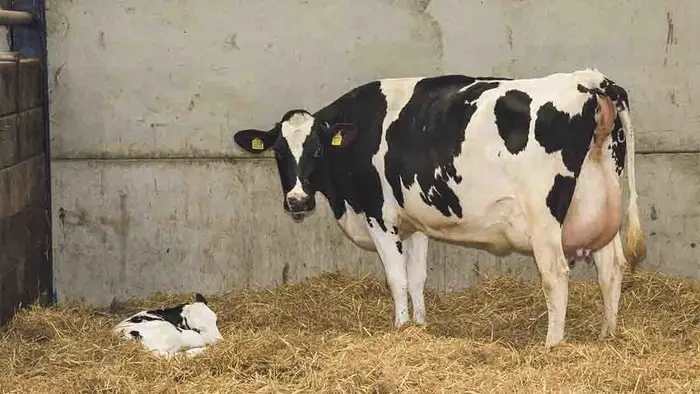
Causes of Postparturient Hypocalcemia
The depression of ionized calcium levels in tissue fluids is the fundamental biochemical defect in parturient paresis. There is a significant fall in all cows at calving, and a significantly greater fall occurs in cows that develop the disease. It appears as a result of an acute imbalance between the output and input in calcium.
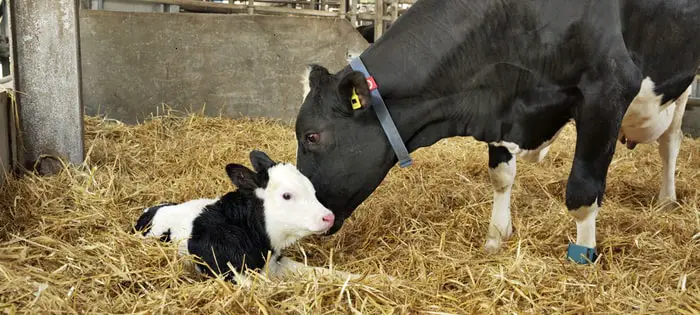
The Predisposing Factor of Milk Fever in Cattle
The common predisposing factors of Parturient paresis are as follows:
- Age Factor: Incidence increases with increased age. Incidence rises with increasing milk production and lactation from the 4 to 6 lactation. Decrease the ability to mobilize calcium from bone and intestinal absorption of calcium in older cows. First heifer cows are rarely affected.
- Breed Factors: Jersey more susceptible, which is unexplained, and might be high productivity in small size breeds.
- Nutritional Factors: Long and short-term factors. Starvation for 48 hours and low-quality feed cause depression of calcium level in blood.
- Seasonal Factors: High incidence at the end of the grazing season.
- Hormonal Factors: Estrogen elevation at parturition and estrus periods that inhibit Ca mobilization, decrease appetite, and reduce intestinal motility reduce Ca absorption.
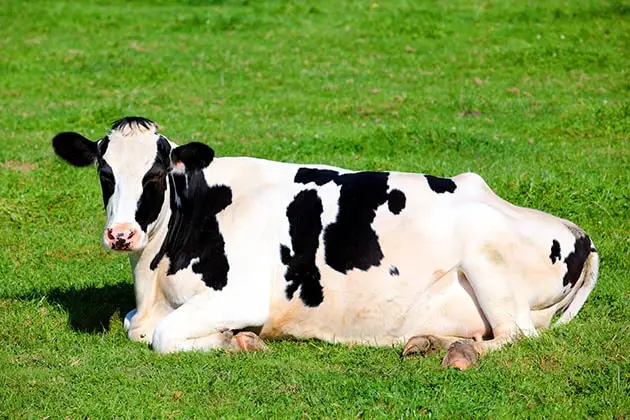
What are the Symptoms of Milk Fever in Cows?
The name ‘milk fever’ is a misnomer because symptoms of the disease do not include a fever. Affected cows have a sub-normal or average body temperature rather than an elevated one. The signs can be divided into three stages:
First stage:
- Mild excitement and muscle spasm.
- Cows are typically nervous, hypersensitive, decrease feed intake, and weak.
- There is a short period where the cow will act excitedly with the muscles’ stiffening and trembling.
- The cow is usually relaxed to move or eat, and later, the hind-legs become stiff, and the cow staggers.
- Cows may have a rapid heart rate and slight temperature during this stage.
- Blood calcium levels will fall below 7.5 mg/dl.
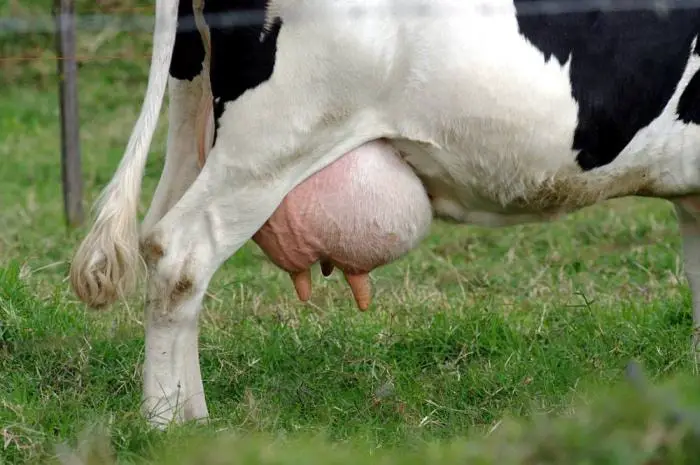
Second stage:
- The cow lies down and can not get up; this stage is called sternal recumbency.
- Milk fever results in paresis and depression and blood calcium will be between 3.5 and 6.5 mg/dl.
- The cow may also exhibit slight muscle tremors with a rapid rate and decreased intensity of heartbeat.
- The extremities of cows will feel cold, especially ears and nose, and rectal temperature will be low (96 to 100° F).
Third stage:
- The cow lies on its body, resting one side with her legs stretched out, and is almost unconscious.
- Bloat may develop, and regurgitation of the rumen contents is likely.
- Only survive a few hours without treatment. If left without treatment at this stage, most animals die.
- Blood calcium may be as low as 1.0 mg/dl, and animals affected by Milk fever also have low blood concentration of phosphorus, whereas blood magnesium levels are usually elevated.
Diagnosis of Parturient Paresis in Cows
History of pregnancy and parturition usually occurs in mature cows aged between 5 to 9 years old, traditionally associated with parturition. A rule of thumb for milk fever diagnosis is to measure the time it takes for animals to stand the following after calving:
- Cows: 15 minutes after calving.
- Heifers: 30 minutes after calving.
- Cows with dystocia: 40 minutes after calving.
If animals are not standing within this time, then check Milk fever. The diagnosis is based on signs and blood analysis.
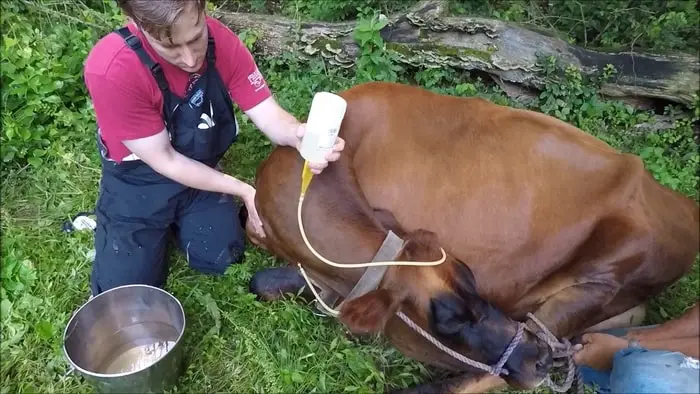
How Do You Treat Milk Fever in Cattle?
The treatment you should be given as early as possible. The essential treatment is to return the serum calcium to the average level with the parenteral injection of calcium borogluconate solution.
- Standard treatment is 500 ml of calcium gluconate, or borogluconate solution provided 10.8g of calcium.
- The dose of calcium borogluconate should be adjusted according to your animals’ body weight and the percentage of solution. For the half-dose, you should be administered IV and rest half SC to minimize the side effects.
It is vital to administer IV treatment slow; at least 12 minutes should be allowed for injection. Sudden cardiac arrest could occur if the injection is administered too quickly. Treatment with solutions that contain calcium, phosphorus, and magnesium has been advocated in complicated cases. The therapeutic response is quick, and the characteristic response in recumbent cows slow muscular tremor, sweating or muzzle, defecation, urination, pulse amplitude, and heart sound intense improves rapidly.
How Do You Prevent and Control Milk Fever in Cattle?
Milk fever will develop from her inability to pull the calcium from her bones. It can occur in one of the following situations-
- One cause is a poorly balanced mineral program that leads to a mineral imbalance in the cow herd.
- Phosphorus is a common mineral that will bind to calcium, making it unavailable to the cow for utilization. Therefore, a diet with a higher percentage of phosphorous over calcium could lead to milk fever because the cow can not use the calcium in the diet.
- Pasture fertilized with chicken litter as fertilizer and chicken litter has a high percentage of both calcium and phosphorous, leading to an imbalance.
- Magnesium oxide should be fed for at least ten days before calving will also prevent Milk fever.
- A second cause is either depressed or excess calcium levels in the diet.
- Excess calcium in the diet can be a significant problem and is usually the number one cause for milk fever in beef cattle.
- Excess dietary calcium can cause the cow to use dietary calcium less sufficiently; therefore, when the demands for calcium increase, at calving, the cow’s body is not prepared to start the process of supplying the additional calcium from the body.
- This will lead to low blood calcium levels and milk fever. The cause of an excess of calcium is usually found in a nutrition program utilizing several products that are high in calcium.
Final Advice on Milk Fever
Milk fever is a common health problem of high yielding dairy cattle—the disease caused by a few factors and management faults. As a farm owner, you have to take adequate management measures. The condition is curable but may hamper you a lot. The consequences of milk fever are permanent recumbency, reduced milk production, increased treatment cost, and animal death.